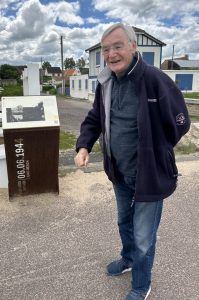
I walked the last few hundred metres along the beach looking expectantly at the skyline of Norman houses. Somehow, I knew I was on the right track. My walking companion, a fellow Canadian and military tour guide, was using a GPS map on his phone as we searched for a small seaside stretch of beach on the Normandy coastline called La Rive Plage. We passed an older gentleman, a local. I stopped and in my high school French I asked him a question.
“Is this the spot where the famous D-Day film was shot?” I asked.
He paused, then realized what I was asking, “Yes,” he nodded and then said, “Keep going farther. It’s up ahead.”
Minutes later, when my colleague Ian Cowan said we’d arrived at La Rive Plage according to his cellphone, I looked back to the man I’d consulted a few minutes before. He motioned, “Just a bit farther.” Then I saw it. A small, rather square two-storey waterfront home with a single-storey detached garage set back from the shore. And the two buildings matched nearly perfectly the image I’d watched in documentaries about the D-Day landings on Juno Beach nearly 80 years ago.

In the foreground, the 35-millimetre motion picture film footage depicts men of the North Shore (New Brunswick) Regiment in an assault landing craft on June 6, 1944. It shows the Canadian soldiers inside moving ladders, rifles and each other closer to the landing craft ramp door.
One man in profile in the film responds to a pat on the back for luck. That man was identified in 2006 by a platoon commander of the North Shores as a Private Baker. Then, the ramp of the landing craft falls forward. The soldiers run down the ramp. In the distance ahead of them are the waterfront home and garage I’ve wanted to locate accurately for almost 20 years.
History is never static. Every time a historian trips over a new journal, piece of correspondence or photo, what was once considered definitive, suddenly changes. And this week, as I travelled with a group of Canadians across the former D-Day beaches helping them visualize events that took place there on June 6, 1944, I was able to share with them my latest discovery.

Back about the year 2000, as I assembled data for a new book about Canada’s role in the Normandy invasion, I found a veteran named Chuck Ross who helped me pinpoint that the iconic landing craft film was shot by his colleague in the Canadian Army Film and Photo Unit, Bill Grant.
To prove that Grant had shot it, I later found CAFPU editor, Ken Ewart, who’d cleared the film with the censors and added sound effects before its release as newsreel footage in movie theatres across Britain and North America. Finally, I received confirmation from the daughter of the dispatch rider who’d delivered Grant’s exposed film in a striped, waterproof bag marked “Press” to a landing craft heading back to England.
“D-Day film taken of Queen’s Own Rifles troops,” the voiceover has always said each June 6 anniversary, “landing in front of the famous Tudor home on Bernières-sur-Mer beach.”
I was never sure about all that. But when Fred Moar, the last surviving officer of the North Shore (New Brunswick) Regiment, identified the profiled soldier in the landing craft as one of his own, all the presumed facts fell into doubt.
Suddenly, the identity of the regiment in the landing craft, the section of Juno Beach and the house in the background were all in question. When British historian Tim Saunders conclusively located the buildings at La Rive Plage, I knew I had to witness the spot myself.

As it turned out, I owed my discovery of the D-Day film location to that gentleman on the Juno Beach walking path. When he caught up to me taking photographs of the spot, I asked him more about his connection to this spot. His name was Lallement Didier. Born in the Netherlands, he had lived and worked in Normandy most of his adult life. My interview in broken French went on.
“So, members of your family were here through the Second World War and witnessed the D-Day landings?” I asked.
He nodded and I could see some remorse in his face. Then he explained, “My family has lived here for five generations.”
“I guess no time tougher than during the occupation.”
He nodded again finally and then extended his hand as if representing all five generations. “A pleasure to thank you Canadians for our freedom.”